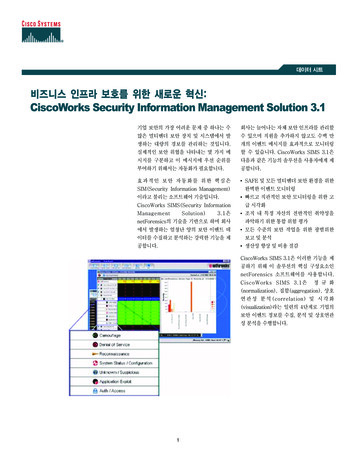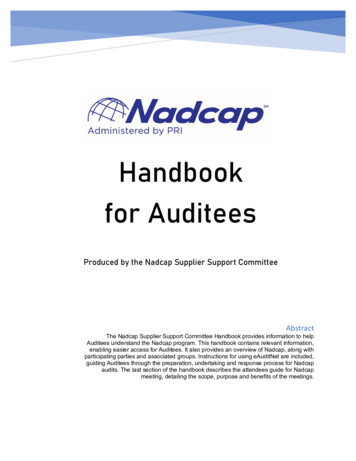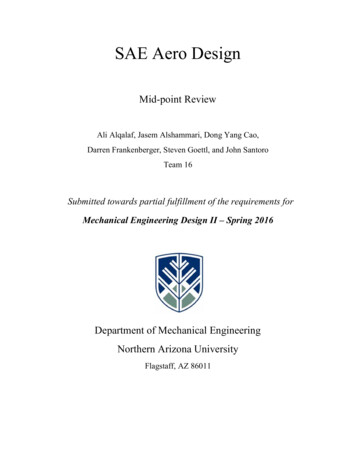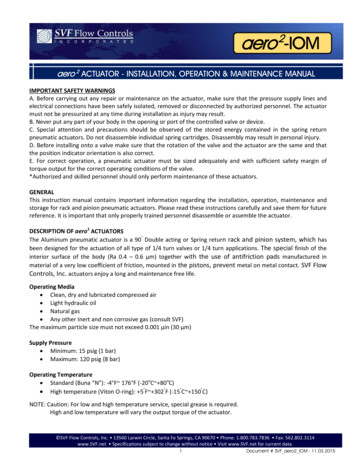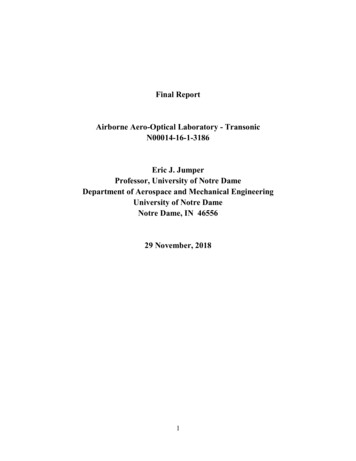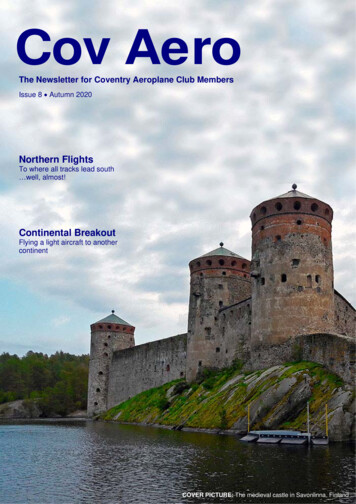
Transcription
Cov AeroThe Newsletter for Coventry Aeroplane Club MembersIssue 8 Autumn 2020Northern FlightsTo where all tracks lead south well, almost!Continental BreakoutFlying a light aircraft to anothercontinentCoventry Aeroplane ClubAutumn2020 PICTURE: The medieval castle in Savonlinna,www.covaero.comCOVERFinland
. News From The Field .The Club Aircraft are Back! Spencer Hedges, Flight Instructor, writes: Students must ring the ops desk when they arrive inthe car park and wait to be called in – the number is02476 301 428Those who arrive early must wait in the car park.No loitering in the reception area used by FSM.The one-way system must be used at all times.All bookings must be made through the ops deskteam (bookings not made through the ops desk will bedeleted).Students are still being prioritised with skills test-readystudents first followed by dual training thereafter.Continued aircraft availability is, of course, dependent onthe latest government guidelines and we will let you knowif anything changes. In the meantime the current situationmakes it imperative that we all Keep Them Clean Please!“Finally, after 5 months of the club’s doors being closeddue to the Covid 19 pandemic and after months or hardwork making the club Covid-secure, we were finallyallowed to reopen our doors and start flying again.At last we were able to open up the Warrior doors, getdusting off the checklists and getting our voices ready forshouting “Clear Prop!”The weather was perfect for our first weekend of beingopen again. Both days had light winds, perfect visibilityand temperatures off the scale! Our members that joinedus on the opening weekend were Darren C, Alister, Nigel,Lauren, Darren K and Luke. A fun couple of days puttingthem through their paces, with plenty of circuits, PFLs,steep turns, navigation and stalling.”It has come to our attention that some licence holdershiring our club aircraft are not sanitising them before orafter use and, in some cases, cleaning has taken placebut the members have then dumped all the contaminatedwaste in the back of the aircraft and left it there forsomeone else to clear up. This is unacceptable and sadlyif this behaviour continues, those members will beprevented from hiring the aircraft in the future, untilsuch time as we are able to resume ‘normal’ operations.Covid bins are placed throughout the building and hangarand are emptied regularly. It isn’t too much to ask to keepthe fleet as safe as we can so that everyone can enjoybeing airborne once again. Please be a team player likeeveryone else and help keep our greatest assets availableto all of us.The No-Deal EASA Exit?Mark Rawlings, Head of Training, writes:Both of our Warriors are back online for private hire anddual training. PPL hirers can book the aircraft in the usualway and we are working through the priority lists of LAPLstudents training with FI Spencer Hedges and PPLstudents training with FI Colin Moore. Big thanks go toColin and Spencer as well as our CFI and FI team forfinding a way to begin flying again.Remember, if you are visiting the club, it is vital that we alladhere to the guidelines set out to keep everyone as safeas possible:Coventry Aeroplane Club“With less than 4 months to go to the end of the Brexitnegotiations it looks increasingly likely that the UK willalso leave EASA on 31st December 2020 with no deals inplace to smooth the process.This affects the School, our Students and ourMembership in a number of ways.From 1st January 2021 the UK CAA will no longer issueEASA licences. Instead they will issue ‘newly created’ UKNational Licences and our School will train people forAutumn 2020www.covaero.com
. News From The Field .these licences with any previous EASA training andexams being accepted by the CAA for licence issue.Many commercial flying schools are changing theirapprovals from the UK to other EASA countries so theycan continue to train for EASA licences. Our students andmembers who have aspirations to progress to becomecommercial pilots should discuss the matter with theirchosen commercial schools and consider changing theirState of Licence Issue (SOLI) to maintain an EASAlicence. Any such SOLI transfer has to be done before31st December 2020.All UK issued EASA licences cease to be recognised byEASA on 1st January 2021.From 1st January 2021 the CAA have agreed a 2 yeartransition period, during which they will accept EASApaperwork as a substitute for the required ‘newly created’UK National paperwork. Therefore holders of UK issuedEASA licences (that includes most of the Club members)will be able to fly UK registered aircraft (that includes theSchool’s aircraft) while they wait for their application for a‘Newly created’ National licence to be processed.Note that existing UK National licences will not convey theprivilege to fly the Club’s aircraft; a new licence will berequired.During the 2 year transition period the UK CAA will alsoaccept UK issued ratings on an EASA licences Thismeans that if someone SOLI’s over to another authorityand then revalidates or renews a rating thatrevalidation/renewal will not be accepted by the UK CAA.So if anyone is considering a SOLI transfer they shouldrenew all ratings say in December 2020 (beforetransferring) so as to obtain the maximum period ofrecognition. They can then apply for the ‘Newly created’National licence as soon as it becomes available.This is a complex subject that is likely to change overthe next few months. We live in hope of a bilateral aviationagreement that will allow the UK and EASA to worktogether.”Thanks to Mark for keeping a watchful eye on thissituation for us. If you have any questions about thisrather complex situation, or if you have any doubts aboutyour validity to fly, then contact a member of the FlightInstructor team who will be able to help you.Annual Christmas Dinner & Awards Ceremony has regrettably been cancelled for this year due to thepandemic situation. Fingers crossed that we will all becelebrating 2 years’ worth of exciting achievements in2021.Have You Been Recently?As the Covid-19 restrictions rumble on, don’t forget thatthe 90-day recency requirement for carrying passengershas not been extended. This means that in order to carrypassengers the pilot in command must have completed atleast 3 take-offs, approaches and landings in a type/classof aircraft within the last 90 days before carryingpassengers in that class/type of aircraft.Now that the club aircraft are available for private hireit’s important to ensure that your 90-day recencyrequirement is being adhered to if you wish to carrypassengers. If you would like a Flight Instructor to adviseyou about your own validity please emaillicencecheck@covaero.comScans of logbooks and licences are accepted.Quadrant is ComingFrom the 5th October 2020 the CAA will be moving its PPLexams away from the existing written papers to thecomputer-based ‘Quadrant’ system. Expect the style ofquestion and answer to expand from purely multi-choiceto include numeric calculation input and drop-down ‘fill inthe blanks’ styles too. Unfortunately there will also be anassociated price increase with the arrival of Quadrant. Anintroductory video is available o v1.mp4Airport Hours of OperationThe current hours of operation for Coventry Airport areTuesday – Saturday 0900L until 1700L. The airport isclosed on Sundays and Mondays. Out of Hoursoperations are still allowed (if you have signed the currentindemnity agreement) but be aware that this is operatingon a much more restrictive first-come-first-served “slot”system compared to the operations allowed over the pastcouple of years. We understand that this has beenimposed by the airport’s board of directors rather than thelocal management team.Conspicuity Tongue TwisterAnyone who’s been up in the air recently has probablyhad the tongue-tying “Squawk Conspicuity” phrasethrown at them when changing frequencies. This is due toa recent change in the AIP which introduced an additionalconspicuity squawk of 2000 for IFR traffic. The knock-oneffect is a change to the CAP413 RadioTelephony Manualwhereby ATS personnel will ask pilots to “SquawkConspicuity” and each pilot must decide whether tosquawk 7000 (if using VFR) or 2000 (if using IFR).Warwick No MoreThe town of Warwick has been a Birmingham AirportVRP for years but from 10th September 2020 it will nolonger be used as such so expect it to disappear from theAIP and your charts. It is hoped that its removal as a VRPwill lead to fewer infringements of the Birminghamairspace above the VRP. The base of Birmingham’s CASin the area is altitude 1500’. As far as we know there areno plans to introduce a replacement VRP.Coventry Aeroplane ClubRoadworksHighways England will be working on the A45 StivichallFlyover from 5th September until 30th November. The workincludes A45 and A46 lane and carriageway closures butshould be mostly carried out overnight (2000L – 0500L)but just bear it in mind if you’re travelling to and from theclub.Stay Informed with CAA SkywiseMany of the news items on this page originate from theCAA’s Skywise service. If you have not already signed upthen head over to the CAA websitehttps://skywise.caa.co.uk/subscribe to receive regularemails from the CAA about subjects of your choosingranging from the latest COVID information to airspacechanges and our upcoming exit from EASA. Amobile/tablet app is available from the same location ifpreferred.Autumn 2020www.covaero.com
Leaving EuropeAs part of CovAero’s JuFly 2019 Challenge, two club members get ataste of flying to another continent for the first time.Part 1 of 2ABOVE: Gibraltar clearly visible from 6000’ – next stop Morocco!I don't know about you but I think one ofthe hardest choices in flying is "where togo". Local or land-away? North orsouth? An old favourite or somewherenew? So with the arrival of the club’ssummer JuFly challenge to land-awayfar and wide in aid of the Aerobilitycharity, we decided to strike out with thetarget of reaching another continent.Africa seemed the obvious choice soTangier on Morocco’s northern coastwas set as the destination with ourfingers crossed that we might be able tostop off at a certain big Rock on the waypast Day 1: Coventry - Rennes - BergeracThe weather at Coventry was overcastbut with clear skies forecast in Francewe were able to set off on time for whatproved to be one of the longest legs,time-wise, as there was an unusuallystrong headwind all the way down toRennes Saint Jaques. We stayed belowcloud all the way to Southampton then,as the bases got lower, climbed up inbetween layers for the channel crossing.As we wafted past the Isle of Wight withthe safety of our MSA in-hand, thetransmitter mast at Chillerton Downpeeped menacingly up at us through thetop of the cloud layer - surely anaviator's reminder to beware below!Coventry Aeroplane ClubThe crossing was uneventful and wecoasted in to France over theCherbourg NDB. Flying in Francegenerally seems subjectively mucheasier than in the UK. In fairness,there’s a lot more sky so VFR traffic isnot squeezed together in the same wayas it might be in the southern half of theUK. Whatever the reasons, ATC isgenerally able to pass you alongseamlessly to the next controller on yourroute - and you can get high too:cruising along at 8000' is not at allunusual.Many of our Euro neighbours adoptthe pragmatic approach to VRP naming:thus VRP "S" will be to the south of thefield; "NW" to the north-west and whathave you. So it was that we arrived atRennes Saint Jaques via VRP "E" whichrouted us, in a glide-clear friendlymanner, nicely round to the east ofRennes' built up areas and onto a 3 milefinal for runway 28. A short taxy to theAéroclub Rennes Ille-et-Vilaine("ACRIV") and that was leg 1 complete.We received the customary warmFrench welcome and nonchalantcustoms formalities into the Schengenarea and, chatting to club memberBernard we picked up on the fact thatACRIV and Cov Aero Club can tracetheir routes to the same year: 1932.Autumn 2020After a standard “aviator’s lunch”(rushed, with a serving of flight planningon the side s’il vous plaît) we wereunderway to Bergerac in the Dordogneregion, about 50nm east of Bordeaux.Now, even a cursory glance at theFrench VFR charts show that the routeis littered with forbidding-lookingrestricted areas, not to mentionnumerous RA(T)s which spring up fromtime to time. Most of the restricted areashave reasonably high bases (typically3000’ AMSL) so our designated ‘plan A’was to charge through them with a 'planB’ of ducking beneath them. TheNOTAMs smiled on us and, as luckwould have it, the areas were either notactive or permission was granted to sailright though. Again, French ATC madethe whole 232nm leg easy andenjoyable. As we touched down onrunway 27 at the end of a successfulday, the temperature was climbingthrough 31 C and we were melting – butwe felt like we were getting somewhere!Day 2: Bergerac - Barcelona - AlicanteDay 2 began with our toughestnavigation exercise so far: gettingourselves airside at Bergerac Airport –and all without the aid of a flightplan orGPS wizardry! At one stage we seemedto be stuck at Ryanair’s departure gatewww.covaero.com
ABOVE: Mont Saint MichelBELOW: Stunning scenery on the Spanish coast near Gironafor Stansted wait a minute, that can’tbe right! One security check later weboarded G-OGEM and hit out for Spain.Throughout the entire duration of the tripwe were blessed with far more days ofgood weather than bad and, althoughthe prevailing weather was generallygood on this leg, we did get theopportunity to give the aircraft a goodwash enroute! As we continued southToulouse and Carcassonne rolled pastdown our port side whilst the terrain inthe distance began to rise into thefoothills of the Pyrenees.It was busier than theNag’s Head on NewYear’s Eve!On this leg we had a lovely day inFrance, warm and somewhat hazy butas the miles counted up and werounded the corner at Cerbere and intoSpain at Portbou it soon changed intothat classic dry Mediterranean heat theBrits know and love. Experiencing thechange in real life makes it easy toappreciate how the might of thePyrenees can literally hold back theweather between the two countries. Ouramicable French ATC friends bade us“Au Revoir” and handed us over toBarcelona Approach – now we’d have todo some real work!To keep us away from high groundand Girona’s CTR we routed out alongthe coast between the Bagur andCalella VORs, inside Barcelona’s classD TMA along with all the Ryanair, Jet2and Iberia traffic heading for BarcelonaEl Prat. It was pretty busy! We wereultimately aiming for Sabadell Barcelona’s principal GA airport - whichsits in class G airspace underneath ElCoventry Aeroplane ClubPrat’s TMA, surrounded by highground and it’s inside a dangerarea and it was busier than The Nag’sHead on New Year’s Eve! Justsqueezing an “Inbound” call out ontoairwaves was like going up against ClintEastwood’s trigger finger but thecontrollers there are sharp and had uson final for runway 31 and on theground in no time. Vacate at Bravo withparking on apron Romeo-2. Welcome toSpain!Contrasting the buzz of activity in theair, it was relatively quiet on the ground;we wandered around the apron andfound a café where we could grab somelunch. The weather was glorious andboth pilots were feeling good so therewas no question we were going to presson for a second leg that afternoon. Oncesaid pilots were refuelled it was time toAutumn 2020refuel the aircraft. Now whilst we wereresearching the trip, I had come acrossa snippet of information on an internetforum which discussed some trouble afellow pilot had run into here atSabadell: he had no chocks for hisaircraft and no chocks meant nofuelling! Not wanting to find ourselves inthe same situation we, before leavingthe UK, had chopped up four pieces ofaluminium angle and linked them intotwo sets of two using bungee cords toproduce a rather nifty, lightweight set ofchocks. As we shut down the engine atthe fuel pumps, the attendant camesauntering over asking if we couldchock the aircraft ready for fuelling.There was definitely a moment of smugsatisfaction as we deftly snapped ournew chocks in place The afternoon leg was a coastal hopdown to Mutxamel which is a great littleGA airfield serving the Alicante area,sitting as it does underneath the class Djust 10 nm north-east of Alicante-Elcheinternational airport. The VFR route outof Sabadell is lively and contorted;especially when routing south andrunway 13 is in use as it was (as thewind had changed whilst we were onthe ground). Once out of the area wewere talking to Reus hoping to negotiatea CTR transit. No luck on this occasionso we headed further out to sea to skirtaround it.G-OGEM has a single-axis autopilotwhich might sound quite modest but itwill hold a heading or a GPS ‘magentaline’ quite admirably and on long,straight legs it allows the pilot flying to a)take a step back to think about theflight’s ‘big picture’ and b) relaxsomewhat! With the aircraft trimmed inpitch it pretty much stays put and it’swww.covaero.com
rather a relaxing way to betransported along the Spanish coast.The Barcelona class D gave way tothe Valencia class E and we wereafforded superb views of the hotelsand properties along the seafront withAlbufera freshwater lagoon beyond.The landscape became drier as wereached the Cap de la Nau and turnedsouthwest past Calp and the almostlegendary Benidorm. Once there, it’spossible to see Alicante in thedistance and it was time to startthinking about descent. Talking toValencia Approach, we skirted undertheir class A and then we were intotheir class D TMA. Mutxamel, beingwell aware of how they need topeacefully co-exist with the nearbyinternational airport, produced a nicebriefing sheet that helped guide usonto a right-hand downwind join forrunway 12. It asks that you turn rightbase over the power lines to the westand that sets you up for a nice final.Arriving at Mutxamel at the end ofthe second day meant that we wereable to take advantage of thegenerosity of Stefan’s family who havea place in Calp, not too many miles tothe north of the airfield. We had somemuch appreciated downtime, eating ata beachside restaurant and taking insome of the local sights afterwards.Day 3: Alicante - Granada - TangierOur original plan for day 3 had beento fly from Alicante to Granada andthen on to Gibraltar where we wouldstay for the night. However, as is theway with GA, things don’t always go toplan! Gibraltar had issued a NOTAMcomplaining of radio trouble whichmeant they were unable to accept anyarrivals – not even visiting charityflights that had been weeks in theplanning! Oh, today of all days! We hada rethink over breakfast and decidedthat we should spend the day routing toGranada as planned and then straighton to Tangier where we would spendthe night – an altogether moreinteresting proposition as it turned out!We checked the rest of the NOTAMs(they looked ok), we checked theweather (it looked hot) and we filed ourflight plan (we used SkyDemon). It’sworth mentioning that every flight inSpain requires a flight plan to be in thesystem prior to departure – even forinternal VFR trips such as ours.Fortunately SkyDemon submits VFRflight plans with aplomb so we weresoon back at Mutxamel airfield andfuelling up for the 255nm, 2½-hour tripdown to Granada.Coventry Aeroplane ClubTOP: Closing in on Mutxamel, Alicante fills the screen.ABOVE: On the ground in the blazing heat at Mutxamel.Granada sits about 25nm inland fromSpain’s southern coast and there is highground between it and the coast whichreaches over 6000’ AMSL – a newconsideration which we simply don’tencounter in the UK. Before filing theflight plan, we had discussed twopossible routings: the first followed theformula which had worked pretty well forus so far by following the coast round tothe south and then routing inland pastthe high ground. The second optionwould have us routing inland to theYeste VOR from where we could tracksouth-west towards the Malaga VORwhich would take us right to Granada; asimpler, more direct route. Both routingshad their own challenges; the coastalroute had us relatively far out overwater, potentially quite low followed by aclimb over the high-ground to get toAutumn 2020Granada whilst making sure to stay wellclear of the 11 414’ Sierra Nevada. Theinland route had us over very highground with rugged, inhospitable terrainfor almost the entire leg. The chart MEFin the area bristles with numbers like“72” and “75” – quite a show for thevisiting UK flat-landers! In the end, weopted for the coastal route. We had notone single reason to doubt the reliabilityof G-OGEM but, should the worsthappen, we were better prepared for awater ditching than a rocky arrival overhot and rugged terrain followed by analmost certain long, arid wait for SAR.So, routing sorted, the first task was toask for a zone transit overheadAlicante’s international airport. Transitgranted no problem – but first we wereasked for one orbit around the “N” VRP“Camp de Golf”. Just need to spot thewww.covaero.com
ABOVE: Routing towards Granada – Rules Reservoir in the foreground, Sierra Nevada on the horizon.BELOW: Can it get any hotter? Refuelling at Granada.golf course ah, there it is! A veritableoasis in the desert. Now that must takesome watering – have a look for it usingan online satellite map and you’ll seewhat I mean! Crossing to the west of therunway 10 threshold we were on ourway down the coast towards Murcia foranother class D crossing of anotherSpanish holiday hotspot. Murcia’sCTR/CTA combination extends from thesurface all the way up to FL115. Todaythe best ATC could offer us was atransit not above 1000’- and 6 miles outto sea. Not the greatest place to be butone that we had briefed and preparedfor. Nonetheless, the sea was calm,there were plenty of ships around andG-OGEM was running like a dream. Infairness, it was quite exhilarating towatch the boats and ships screamingpast below us. We also saw someoffshore fish farms which is somethingI’d never seen before. Best not todisturb those then!Once out of the CTA (but still withinthe class D CTR) we asked for a climbto 6000’ which was duly granted. Nextup was Almeria where we were alloweda transit at 6000’ – much better thankyou very much! Anyone who hasholidayed in Almeria will no doubtremember the endless sea of whiteCoventry Aeroplane Clubplastic greenhouses to the west which isvisible from the ISS in Earth orbit. Sittingat the pointy end of the aircraft for once,we could more easily appreciate theextent of the sprawl. It goes on forliterally dozens of miles and actuallyencompasses several medium sizetowns. The area is responsible forproducing more than half of Europe’sdemand for fresh fruit and vegetablesbut is also sadly often associated withallegations of modern slave labour usingillegal immigrants and the dumping ofvast amounts of plastic waste along thecoast. Food for Europe yes, but perhapsfood for thought too as we fly past onour transit.A further climb to 7500’ had usperfectly placed to deal with the highground and also took us over the top ofdanger area D111 which stretches fromthe surface up to 6550’. We crossed thepeaks and the ground started fallingaway again down towards Granada,itself within danger area D109.However, we were given permission toenter and made our way down towardsthe floor of the plain where the airportsits at an elevation of 1851’ AMSL. Likemost of the major airports along theroute handling is required and, as wewere about to leave Europe, we alsoAutumn 2020required a customs check to authoriseour departure from the Schengen area.As the heat on the apron crawledtowards 40 C we reflected on the “up”side of handling as the handler’s airconditioned minibus chauffeured usaround the airfield. They could not havebeen more helpful - ok, that’s whatyou’re paying for but they showed agenuine interest in our trip too, whichwas a pleasant experience.In an effort to take on as little fuel aspossible at Tangier we refuelled to thebrim at Granada and waddled on to therunway at MTOW. Back in the UK,density altitude is not something thatroutinely worries us but on this day itwas something we definitelyconsidered. Granada’s 2900m runwaymade it something of a non-eventalthough the increased ground roll andreduced climb performance weredefinitely noticeable. Granada ATC hadalready cleared us to enter the SevilleTMA which lies above Granada; onceinside the TMA we arranged a transitoverhead Malaga airport – no problemshere, straight over the thresholds of thefamous twin runways of the Costa delSol. As we passed the headland atPunta de Calaburras the coast curvesaway to the west and our straight trackhad us heading south-west out over theMediterranean. This was it, the big one!The Seville class D TMA gives way toclass E then there’s a strip of class Dagain to the east of Gibraltar. From ourvantage point at 6000’ we could seeGibraltar itself along with Punta deTarifa - the southernmost tip ofmainland Europe - and the coast ofnorth Africa all at the same time. DoesGA get any better than this?The Moroccan AIP defines a numberof seemingly strict VFR routes in thearea so we routed towards the MalabataVRP which defined one of the startingpoints. As we contacted Tangierapproach they rather unexpectedlyasked us to confirm our radial and rangefrom the TNR VOR/DME. Kudos toStefan for dialing in 108.05 and lining upthe OBS in double-quick time (bonuspoint for any reader who can rememberthe morse for “TNR” off the top of theirhead!) We were on the 060 radial at 16www.covaero.com
miles. “Report final, runway 28” camethe reply. Well that was easy! As weswung G-OGEM to the left to setup arunway intercept heading the city ofTangier rolled out before us. I don’tknow why but I half expected the leg toTangier to throw us some complicatedcurved balls but it absolutely did not.The ICAO-compliant runway 28 cameinto view along with its ICAO-compliantPAPIs and approach lighting guiding usdown to a completely standardtouchdown. It was no more difficult thanlanding at Gloucester or Turweston. Butthis was Africa and we patted ourselveson the back as we taxied to parking onthe GA apron.Night 3: TangierWe chose Swissport as our handlingagent as we figured it would be to ouradvantage to have some professionallocal help. That turned out to be a greatdecision, not least because they senttheir black Mercedes VIP van out tocollect us. We requested fuel beforeleaving for the hotel to help ensure atimely departure the next morning. Aftera mountain of paperwork, signaturesand “cash only” had been exchangedwe ended up having to pull the aircraft,by hand, across the scorching hotMoroccan tarmac to the AVGAS fuelbowser which had clearly seen betterdays! Several ripcords later it chuggedinto life; dirty exhaust fumes spewingout and looking every inch as though itran on lumps of coal and oldmattresses. Its AVGAS, however, wassparkling clear and G-OGEM lapped itup. Our Swissport agent then drove usin air-conditioned luxury to the mainterminal and deftly negotiated our waythrough passport control. Once outside,she instructed the taxi driver exactlywhere to drop us at the hotel and whattime to pick us up again the nextmorning – proper service.The taxi ride to the hotel showedTangier have much in common withmany other cities: glittering high riseblocks within a stone’s throw of thehomeless living on streets. Our hotelwas in the ‘old’ town which has much ofthe lower half of its buildings and wallspainted blue. The hotel checked us inand plied us with green tea and cakebefore we headed out to explore andget something to eat. We had landed inMorocco a day earlier than planned dueto the closure of Gibraltar and, as ithappened, it was the night before Eid.Virtually all restaurants were closed asmost of the locals busied themselvespreparing for the end of Ramadan thefollowing day. We wandered around themarkets and narrow passages taking inCoventry Aeroplane ClubTOP: Not something you dial in to your GNS430W every day.ABOVE: On the ground in Morocco as our air-conditioned Limo waits patiently in the sun.BELOW: The hotel in Tangier old town.the sights, sounds and smells and thenran into a local “tour guide” or perhapsthe “tour guide” selected us and madesure we ran into him! I have a feelingAutumn 2020that there might be many such tourguides in Tangier but our fellow seemedharmless enough and offered to take usto his family’s restaurant which waswww.covaero.com
open and nearby. Perhaps first though,he proffered, we might like to pay a visitto his “Uncle’s” shop. Ah, now weunderstand what’s going on – and it’s allpart of the experience anyway so let’splay! The shop sold a huge variety oftrinkets, ornaments, rugs, crockery,pictures pretty much everything anytourist might ever ask for. Up on the wallwas a framed, mid-1960s photograph ofactor Anthony Quinn purchasing a fez inthis very store. Wow - we were in goodcompany and “Uncle” seemed pleasedthat we had spotted Quinn. We had thefull Moroccan bartering treatmentcomplete with “Uncle’s” mock horror atthe offers we were making. “Come, sitdown and we’ll discuss”, he would say,gesturing towards the “bartering” sofa.This was not like shopping in Tesco! Asa side note, it was interesting to notethat the shop accepted any currency –all barriers to tourists spending moneyreally had been removed! So, trinketspurchased, everyone was satisfied andwe left for the restaurant.As good as his word, our guide led usto a restaurant which was indeed openand the food was good to boot! Onesmall detail though – our unexpecteddetour to “Uncle’s” shop had left usrather short of local currency. That alsoturned out to be no problem as therestaurant owner could send a runnerback with us to the hotel to pick up thecash! Our tour guide stayed with usthroughout the entire meal; chattingCoventry Aeroplane ClubABOVE: “Just act natural” – enjoying the restaurant whilst our “Tou
Both of our Warriors are back online for private hire and dual training. PPL hirers can book the aircraft in the usual way and we are working through the priority lists of LAPL students training with FI Spencer Hedges and PPL students training with FI Colin Moore. Big thanks go to Colin and Spencer as well as our CFI and FI team for




